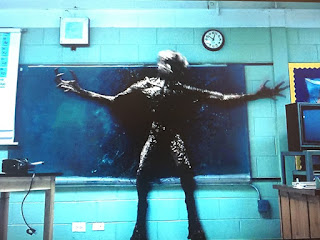After finishing the first season of Stranger Things (2016-) on Netflix, I was impressed with the stylish homages to 1980s films from Spielberg (Poltergeist, E.T., Jaws, Close Encounters, etc.) and John Carpenter (Halloween, The Thing, etc.) (among others), as well as the novels of Stephen King. We see overt references to Cujo in one scene, and the logo broaches Christine. State Trooper O'Bannons name also references Alien, written by Dan O'Bannon, and Chief Hooper's name broaches Predator. These
are just a few of the homages in the series, but they also point to one
of the touch points for horror--monstrous nature. Much of Stranger Things draws
on skeptical views of science found in horror and sci fi films,
highlighting a mad scientist and monster created by his flawed
experiments. The wooded "Indiana" (shot in Georgia) setting amplifies
its themes, especially when the "underneath" space is introduced. These
same monstrous nature ideas are explored explicitly in another 1980s
film--The Nest (1988)
The Nest explores
the possible disastrous consequences of a biological experiment that turns
roaches into flesh-eating fiends. The
Nest copies Alien (1979) with its focus on the corporate science
connection, ultimately leading to the discovery of a queen and her brood hidden
deep in a cave outside an idyllic California coastal town. The film serves as a
warning against genetic modifications of cockroaches, a transformation that
turns bugs into horrifically anthropomorphized monsters. Negative associations
with the insects heighten their monstrous qualities as they take center stage
from the film’s opening until its closing denouement. These cockroaches are
first established as pests that must be eradicated but transform into monsters
that may ultimately destroy humanity instead.
The film opens in the small harbor town of North Port where Sheriff
Richard Tarbell’s (Franc Luz) switchboard officer has been getting strange
calls about missing animals, calls that are immediately connected to insects
when Tarbell finds a cockroach in his coffee at a diner counter. The presence
of cockroaches is also reinforced when the librarian reveals that
something—mice or insects—has eaten all of the binding out of her library
books. The central cockroach drama, however, intertwines with a subplot of the
film, a love triangle Tarbell creates between himself and two women, the
diner’s owner Lillian (Nancy Morgan) and his previous girlfriend Elizabeth
(Lisa Langlois). The reigniting of Tarbell and Elizabeth’s romance begins to
solve the mystery broached by the cockroach evidence. When Elizabeth takes a
walk toward the hideout of their youth, she finds a “no trespassing” sign
labeled “Intec Development.” A German Shepherd’s cries of agony stop her, and
when she reaches him, his flesh has been eaten down to the bone. Tarbell investigates
and retrieves something that looks like insect droppings on the dog, yet
village mayor Elias urges Tarbell to hold off on searching the Intec property
for more evidence. He claims Intec is building condominiums to bring revenue to
the island.
The Nest also
constructs scientists as monsters when Intec sends an entomologist, Dr. Morgan
Hubbard (Terri Treas), to the island to examine the devoured dog. Dr. Morgan
serves as a typical representative of the inhuman and perhaps “mad” scientist
seen in most classic monster movies. Dr. Hubbard’s response to these incidents
emphasizes the negative portrait of science and scientists in the film. Instead
of the fear felt by the rest of the community, Dr. Hubbard seems enamored by
the roaches and explicitly anthropomorphizes them. For example, when the
cockroaches attack a trapped cat, she exclaims, “very brave, very strange
creatures,” a point emphasized by the few predators that can threaten the
cockroach. These strengths add to the town’s danger but also draw on cockroach
mythology.
Because they have been genetically modified in an Intec lab, the
roaches have developed new powers, more concretely illustrating human and
god-like qualities associated with them. Because she has produced them, Dr.
Hubbard embraces these new superior but deadly qualities, naming them nymph
cockroaches. She lauds their ability to reproduce without the contributions of
male counterparts, but when she puts her gloved hand near them in a large lab
container, they quickly bite it, highlighting their move from human prey to
predator. As a “mad” scientist, however, she seems sexually excited by the
mangling of her hand, refusing to remove it until Elias pulls it out before the
roaches devour it. Despite these warning signs, Dr. Hubbard tells Elias she can
control the roaches and asks for twenty-four hours to solve the problem.
Beth’s examination of Elias’s papers begins to reveal the truth about
these cockroaches’ genetic alteration. Instead of condos, Intec has built a
research facility where, according to Hubbard, her experiments are benevolent
rather than destructive and meant to create cockroaches that will destroy all
other roaches and then die without reproducing. Instead the cockroaches have
grown so powerful that even a lethal pesticide can’t destroy them. A solution
arises when they realize the roaches have become social animals and must have a
nest and a queen to guide them.
The final sinister scenes of the movie emphasize a possible solution
to the horror of this now monstrous nature. As Beth explains, if they destroy
the caves, they will destroy the nest, suggesting that if they destroy the
horror setting, the monstrous insect horror will also disappear. The roaches
all go toward the queen in the caves like “a collective unconscious,” making an
overt connection to an anthropomorphized cockroach mythology. In the cave where
the nest is hidden, Dr. Hubbard is destroyed by a roach figure built out of
multiple human skeletons. Tarbell and Beth escape the cave before it explodes,
and the two kiss, an ending that perhaps satisfactorily resolves the insect
conflict in the film but leaves gaps in the love triangle connecting with it.
In The Nest, both science and the
cockroach become monstrous, but only the bugs and the mad scientist die,
perhaps signifying the need to destroy our worst selves. In Stranger Things, science also destroys.












No comments:
Post a Comment